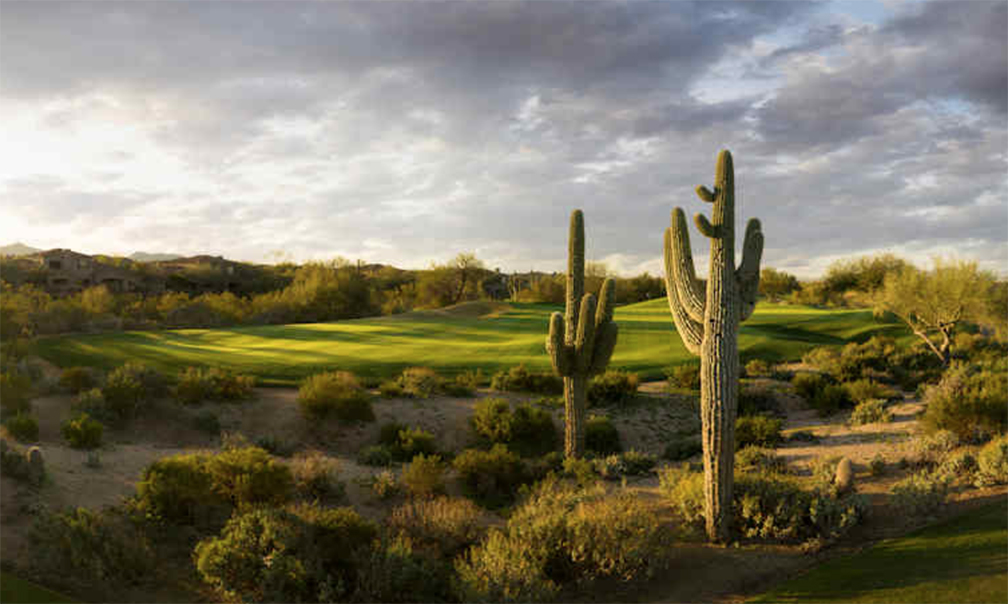
The Talon course at Grayhawk
When Ernie Banks, the Chicago Cubs Hall of Fame outfielder, famously said “Let’s play two” he was talking about his love of baseball doubleheaders and playing two games in the same day.
But Banks’ famous catchphrase easily translates to the golfers who tee it up at these three golf facilities in the megalopolis in and around Phoenix. Arizona. This is a region that’s the home of more than 200 courses, most of them verdant oases among the sand and cactus and scrub brush.
If you’re a golfer or a golf traveler – and that’s likely the case if you’re reading this – you’re well aware that if there is a golf heaven, a place you could play a different and invigorating course nearly every day of the year, it’s the “Valley of the Sun.”
In this feature, we take a look at a trio of golf destinations that offer two courses each at their respective facilities. These aren’t the only three such places in the area; when you’re looking for double the fun while only having to park your car once, the Phoenix/Scottsdale area is tough to beat.

Talking Stick’s Piipaash course
Talking Stick’s two courses offer different challenges
The desert around Phoenix can be rigid and austere, but a closer look at this very-alive and unique palate reveals more. It is with this far-from-bland environment that the renowned golf-architecture team of Bill Coore and Ben Crenshaw fashioned the two superb golf courses at Talking Stick Golf Club.
The two 18s, both opened in 1998, were Coore & Crenshaw’s first design in the Arizona desert. Upon an initial inspection, it’s difficult to comprehend how the duo manipulated the 350 acres of open farmland east of Scottsdale into such a tour de force for all levels of linksters.
Both courses blend with their surroundings to provide a serene yet challenging experience. The wide playing corridors are a sea of green. Not surprisingly, the courses are Certified Audubon Cooperative Sanctuaries. The resort occupies land where the horizon seems to never end, broken only by occasional barbed-wire fences and creosote, mesquite and Palo Verde trees.
One can almost imagine that Coore and Crenshaw created the courses with brushes rather than bulldozers, as there are virtually no changes of elevation on the site.
Instead, the O’odham Course (formerly the North course) utilizes a links-style routing to lure golfers, while the Piipaash Course (formerly South Course) is more of a parkland, tree-lined layout (more than 4,500 trees were imported to define fairways).
“We wanted to portray two different but traditional golf experiences at Talking Stick, as the courses quietly merge with their tranquil desert surroundings,” said Coore. “The land was totally flat and treeless, so the beauty was for golf only and not a housing development. We were told to make the courses as opposite as we could, but make them user-friendly.”
Following that dictum, there is nothing tricky about the courses at Talking Stick Golf Club. Everything is right in front of you, but what makes these layouts challenging are its approaches and greens. More than 100 bunkers combined enter play on the two courses, and they are most punitive around the often-huge putting surfaces.
The 7,133-yard, par-70 O’odham Course offers views of Camelback Mountain, the McDowell Mountains and Pinnacle Peak. O’odham offers many options and features low-profile, slightly crowned putting surfaces and tightly-cropped approaches to encourage players to use the ground as well as the air.
Some of the fairways are as wide as runways, but things get interesting if the golfer isn’t careful on the approach as they may end up in some very deep bunkers.
Muscle up for O’odham’s final four-hole stretch, which consists of the two longest two-shotters (the 461-yard 15th and the massive 471-yard closer), the longest hole (the side-winding 582-yard, par-5 17th), and the 194-yard 16th.
O’odham keeps the player thinking, without beating him or her over the head with tricks or gimmicks. If one has good club control, can use imagination to get the ball on the greens and make a few putts, the course can be scored on. It’s a cool test and a real treat.
According to Coore, the Piipaash Course is more straightforward than its counterpart. It features more trees and water while involving subtle elevation changes, fingered bunkers, tiered landscaping and native cottonwoods and hardwoods.
Piipaash has some of the characteristics of its sister course, such as generous fairways, but is different in that is has many more trees. The player will need to work his ball more on par-71 Piipaash, which plays shorter than its sibling at 6,833 yards from the tips.
Coore and Crenshaw built the 548-yard 16th with a “wee burn” (the hole’s name) that starts about 100 yards out from the green and runs to the left past the putting surface. “Real sticks” can have a go on the 323-yard, par-4 closer, but they’ll need to carry water most of the way to reach the promised land.
While O’odham has perhaps the more memorable holes, Piipaash is wonderful for its collection as well.
Talking Stick is an amenity of Talking Stick Resort, which is located on and owned by the Salt River Pima-Maricopa Indian Community. The resort east of Phoenix and Scottsdale is named after the traditional Pima calendar, a wooden branch carved to mark significant events in the tribe’s history.
The courses at Talking Stick Golf Club have received scads of kudos and both are must-plays when in the “Valley of the Sun.”







Wildfire shows off design chops of Palmer, Faldo
Wildfire Golf Club in the rugged Sonoran Desert of northeast Phoenix features a pair of picturesque layouts designed by Arnold Palmer and Nick Faldo. The 36-hole facility, the golfing option at the opulent JW Marriott Desert Ridge Resort & Spa, offers distinctive golf experiences.
Located just 16 miles from downtown Phoenix and 10 miles from downtown Scottsdale, Wildfire opened in 1986 with the Palmer Course. Faldo brought his brand of magic to the site in 2002.
The Palmer Course is more traditional, with a target-golf feel and large greens, while the Faldo contains a bevy of bunkers.
Playing at 7,145 yards from the back set of five tees, Wildfire’s Palmer Course can provide a stern test even for the pros, although the various tees provide any category of player a fun round. Palmer’s wide and relatively flat fairways help keep golfers in play, while bunkering and vast putting surfaces create subtle challenges. It’s not uncommon to have 30-, 40- or even 50-foot putts up or down severe undulations.
The par-72 layout favors long hitters as two of the four par-3s measure at least 205 yards and all but a pair of the course’s par-4s stretch 415 yards or more.
No. 17, which many consider the best hole at Wildfire GC’s two courses, is a monster of a par-4 at 450 yards, with water protecting the green. The par-4 finisher runs 430 yards to a narrow, wavy green.
The desert surrounding the Palmer Course is more penal than at the Faldo, and if one drives the ball offline it’s difficult to find. The Palmer Course is target golf, pure and simple, as ravines cut across many fairways.
The par-71 Faldo Course, which plays at 6,846 yards from the tips, is the shorter of the two courses at Wildfire but it might be better than its older sibling. The design by the six-time major winner, in conjunction with the architectural team of Lee Schmidt and Brian Curley, features devilish and perfectly placed bunkers on each hole, forcing players to double-check yardages from tees and fairways.
The track involves 174 acres and offers a slight variation from the typical desert-style courses. Century-old Saguaro cacti and 108 bunkers that flash up anywhere from five to 25 feet are reminiscent of Australia’s Sandbelt courses.
This is a course unique to the Valley, not just because of the design but because it is so position-oriented. The Faldo is an interesting combination of short and long par-4s, dramatic par-3s that optimize the property’s vistas, and clever par -5s that reward placement over power.
The biggest difference between Faldo and Palmer courses is the size of the greens. Faldo’s has some postage stamp-sized putting surfaces that are difficult to hit. Take the par-3 third. Playing just 164 yards from the tips, with bunkers left and right, it forces the golfer to select the right club. A steep drop-off long and left adds to the challenge.
The closing hole on the Faldo Course (a 420-yard par-4) sports 10 bunkers, and, from an elevated tee, provides a heart-pounding view of the resort at the rear of its green.
Wildfire Golf Club and its tandem of courses have been voted “Best Courses You Can Play” by Golfweek magazine, and two of “America’s Top Golf Courses” by Zagat. Both layouts offer amazing vistas. No matter your choice, you’ll find a challenging layout from start to finish. So why not stay overnight and play both? Ernie Banks knows how you feel.




Grayhawk is among the Valley’s best daily-fee facilities
The pair of highly-rated tracks at Scottsdale’s Grayhawk Golf Club and Its two courses — Talon and Raptor — feature all the best things about upscale, daily-fee golf in the desert. Course conditioning here is impeccable, the service is top drawer, and the tracks are challenging — though occasionally punitive, especially if the player is not spot-on with his or her game.
Both courses at Grayhawk are routed in the shadows of Pinnacle Peak, and circumnavigate the foothills of the McDowell Mountains in the scrub-brushed desert dotted by thousands of ocotillo, saguaros and ironwood. Talon was designed by former U.S. Open and PGA champion David Graham and golf course architect Gary Panks, while Raptor is a Tom Fazio creation.
The two courses have differing personalities: little quirky elements that one finds suits his or her game or doesn’t.
Precision is the name of the game here, as – even with Raptor’s relatively wide fairways — wayward shots will find desert detritus which is mere feet off the manicured playing surfaces.
The key to success at Talon, opened in 1994, is to play shots to places where the large and sectored putting surfaces can be attacked aggressively. The par-72 track is 6,973 yards.
Perhaps Talon’s most fun hole is the 126-yard 17th, which features an island green. The closer, a 588-yard, dogleg-right par-5, characterizes the Graham/Panks’ risk-reward philosophy.
Some consider Talon the lesser of the two courses at Grayhawk, but that’s a fallacy — both are enjoyable and memorable.
Fazio’s finished product at the Raptor course is thought to be more punitive than Talon. Opened in November 1995, the par-72 Raptor has formidable length, carded at 7,151 yards from its back set of five tees.
Raptor has scads of holes with cross-bunkering that pleases the eye but are formidable and must be avoided. Another area to avoid is the greenside bunkers, which are deep and profoundly sculpted. The putting surfaces, many of which are mounded and terraced, can be made more treacherous with some killer pin placements.
Fazio stocked Raptor with behemoth two-shot holes, three of which are at least 460 yards from the way-backs. But despite its length, Raptor is a track that must be played with feel and sound course management.
The final three holes at Raptor complete a satisfying round. Raptor’s closer — a 521-yard par-5 — has water along the right and two bunkers pinching the prime landing area. The shot to the cape-style green must evade bunkers left, right and rear.
Standing in the 18th fairway looking down the hill at the green is a stunning sight. The large outdoor seating area around the club’s famous restaurant, Phil’s Grill, sprawls behind the pond that dwarfs the green.
Raptor’s variations of long and short holes give players ample opportunity for birdies as well as tough pars. The tournament-worthy course was the former host of the PGA Tour’s Frys.com Open.
The offerings of great golf here are seemingly endless, as courses work hard to out-do each other to draw patrons and give customers an experience that will bring them back again and again.







